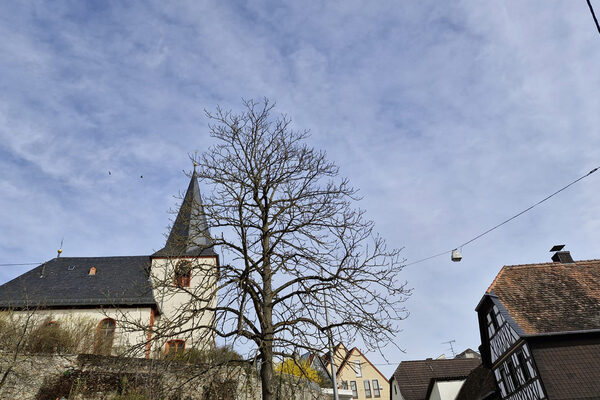Igstadt: Igo and the Counts of Ziegenhain
The beginnings of Igstadt probably date back to the Frankish occupation of the land in the sixth and seventh centuries.
Early history and origin
A Franconian burial ground, which was discovered in 1946 during the construction of a barn, could contribute to a more precise dating of the early history of the village. However, it has not yet been archaeologically investigated. The place name is probably derived from a Frankish landlord called Igo.
First mentions
Igstadt is first mentioned in documents in 1241 and 1251, when the Igstadt village priest Arnoldus acted as a witness for legal transactions in neighboring communities. From the second half of the 13th century onwards, there are more than twenty documents naming the Mainz Altmünster monastery as the local lord. The Mainz cathedral chapter and St. Peter's Abbey also owned land in Igstadt in the 13th century.
Influence of the Altmünster monastery
The largest landlord was the Altmünster monastery, which owned 400 acres of land in Igstadt. In the 14th century, a knight from Igstadt donated a farm with 130 acres of land to Gnadenthal Monastery. Both monasteries leased their estates to Igstadt farmers. The lease agreements can be traced back to the 19th century.
Change of power in the 15th century
The balance of power changed in the 15th century: The Counts of Ziegenhain, who had previously held the bailiwick over Igstadt, bequeathed it to the Landgraviate of Hesse. After Gottfried IX von Eppstein sold the "Ländchen" villages to Hesse in 1492, the Landgraves of Hesse-Marburg and Hesse-Cassel increasingly ousted the Altmünster monastery from its sovereign rights. From 1532, only the Hessian bailiff had control over Igstadt.
Destruction in the 30 Years' War
Igstadt suffered heavy losses during the 30 Years' War. From 73 households in 1610, only 20 inhabitants remained in 1643. Many houses were destroyed and the population fell victim to looting. The Altmünsterhof with the tithe barn also burned down. The Altmünster monastery then reduced the grain rent and asked the tenants to rebuild the buildings.
Progress in the 18th century
In the 18th century, the sovereignty of Hesse-Darmstadt created new registers and recorded 75 farmsteads. Despite the burdens of the wars of this century, Igstadt slowly grew again. In the years between 1726 and 1728, the old church was replaced by a new building. The Altmünster monastery donated a valuable crucifix for the consecration.
19th century: Change and growth
In the 19th century, a series of changes further advanced the village community. Taxes such as Fastnachtshühner and Jagdthaler were abolished, and the land experienced improvements through land consolidation and a new tax system. Igstadt grew from around 480 inhabitants in 1817 to around 750 at the end of the century. A railroad station was built in 1879 and the water tower became a landmark of the village. The connection to the electricity supply came in 1911.
The First World War and the years that followed
38 Igstadt residents fell in the First World War, whose names are immortalized on a memorial stone in front of the cemetery gate. After the war, Igstadt was also occupied by foreign troops - first French, then British. In 1924, the settlers' association Eigenes Heim Igstadt was founded, which helped 19 people to build their own homes. As a result, 16 semi-detached houses and three detached houses were built on today's Florian-Geyer-Straße. New church bells were consecrated in 1927.
Igstadt was incorporated into Wiesbaden in 1928. Among other things, this brought a connection to the municipal gas supply and an improved infrastructure.
National Socialism and the Second World War
In 1930, an NSDAP cell was formed, which grew into a local group by 1938. Several Jewish families were forced to sell their homes and leave the town. The anti-Semitic measures of National Socialism also had a lasting impact on the Igstadt community, but a complete reappraisal of this period is still pending.
During the Second World War, Igstadt was hit by a bombing raid in 1945, in which a residential building and several barns were destroyed. 88 Igstad residents lost their lives.
Reconstruction and growth
After the war, the population grew from 1,092 to 1,477 in 1950 due to the influx of displaced persons. Infrastructure projects were carried out in the following years: the demolition of the old town hall in 1957, the extension of the school in 1954 and the development of new building areas, initially on the outskirts of the village, later also in the village center. In 1984, the local council started the redevelopment of the historic town center, which was listed as a historical monument in 1988 and renovated in the 1990s.
Close to Wiesbaden
Today, the Igstadt district is farmed by a small number of full-time farmers. In 2009, there were 177 commercial enterprises, mainly small businesses. Most of the inhabitants work in Wiesbaden and the Rhine-Main region.
Historical highlight
The Igstadt local history association preserves the history of the village with information boards, for example at the former village smithy in Bornstraße.
